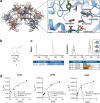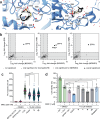Sulphostin-inspired N-phosphonopiperidones as selective covalent DPP8 and DPP9 inhibitors
- PMID: 40180908
- PMCID: PMC11968843
- DOI: 10.1038/s41467-025-58493-z
Sulphostin-inspired N-phosphonopiperidones as selective covalent DPP8 and DPP9 inhibitors
Abstract
Covalent chemical probes and drugs combine unique pharmacologic properties with the availability of straightforward compound profiling technologies via chemoproteomic platforms. These advantages have fostered the development of suitable electrophilic "warheads" for systematic covalent chemical probe discovery. Despite undisputable advances in the last years, the targeted development of proteome-wide selective covalent probes remains a challenge for dipeptidyl peptidase (DPP) 8 and 9 (DPP8/9), intracellular serine hydrolases of the pharmacologically relevant dipeptidyl peptidase 4 activity/structure homologues (DASH) family. Here, we show the exploration of the natural product Sulphostin, a DPP4 inhibitor, as a starting point for DPP8/9 inhibitor development. The generation of Sulphostin-inspired N-phosphonopiperidones leads to derivatives with improved DPP8/9 inhibitory potency, an enhanced proteome-wide selectivity and confirmed DPP8/9 engagement in cells, thereby representing that structural fine-tuning of the warhead's leaving group may represent a straightforward strategy for achieving target selectivity in exoproteases such as DPPs.
© 2025. The Author(s).
Conflict of interest statement
Competing interests: A.L. is an employee of Proteros Biostructures GmbH. The remaining authors declare no competing interests.
Figures





Similar articles
-
Establishment of a dipeptidyl peptidases (DPP) 8/9 expressing cell model for evaluating the selectivity of DPP4 inhibitors.J Pharmacol Toxicol Methods. 2015 Jan-Feb;71:8-12. doi: 10.1016/j.vascn.2014.11.002. Epub 2014 Nov 15. J Pharmacol Toxicol Methods. 2015. PMID: 25464020
-
Vildagliptin-Derived Dipeptidyl Peptidase 9 (DPP9) Inhibitors: Identification of a DPP8/9-Specific Lead.ChemMedChem. 2022 Aug 3;17(15):e202200097. doi: 10.1002/cmdc.202200097. Epub 2022 Jun 27. ChemMedChem. 2022. PMID: 35760756
-
Structure-activity relationship studies on isoindoline inhibitors of dipeptidyl peptidases 8 and 9 (DPP8, DPP9): is DPP8-selectivity an attainable goal?J Med Chem. 2011 Aug 25;54(16):5737-46. doi: 10.1021/jm200383j. Epub 2011 Aug 2. J Med Chem. 2011. PMID: 21711053
-
Dipeptidyl peptidase inhibitors, an emerging drug class for inflammatory disease?Trends Pharmacol Sci. 2009 Nov;30(11):600-7. doi: 10.1016/j.tips.2009.08.003. Trends Pharmacol Sci. 2009. PMID: 19837468 Review.
-
Advances in understanding the expression and function of dipeptidyl peptidase 8 and 9.Mol Cancer Res. 2013 Dec;11(12):1487-96. doi: 10.1158/1541-7786.MCR-13-0272. Epub 2013 Sep 13. Mol Cancer Res. 2013. PMID: 24038034 Review.
Cited by
-
The multifunctional regulatory post-proline protease dipeptidyl peptidase 9 and its inhibitors: new opportunities for therapeutics.Cell Mol Life Sci. 2025 Apr 28;82(1):187. doi: 10.1007/s00018-025-05719-4. Cell Mol Life Sci. 2025. PMID: 40293537 Free PMC article. Review.
References
-
- Zhang, X. & Cravatt, B. F. Chemical proteomics–guided discovery of covalent ligands for cancer proteins. Annu. Rev. Cancer Biol.8, 155–175 (2024).
-
- Gehringer, M. & Laufer, S. A. Emerging and re-emerging warheads for targeted covalent inhibitors: applications in medicinal chemistry and chemical biology. J. Medicinal Chem.62, 5673–5724 (2019). - PubMed
MeSH terms
Substances
Grants and funding
LinkOut - more resources
Full Text Sources
Miscellaneous

